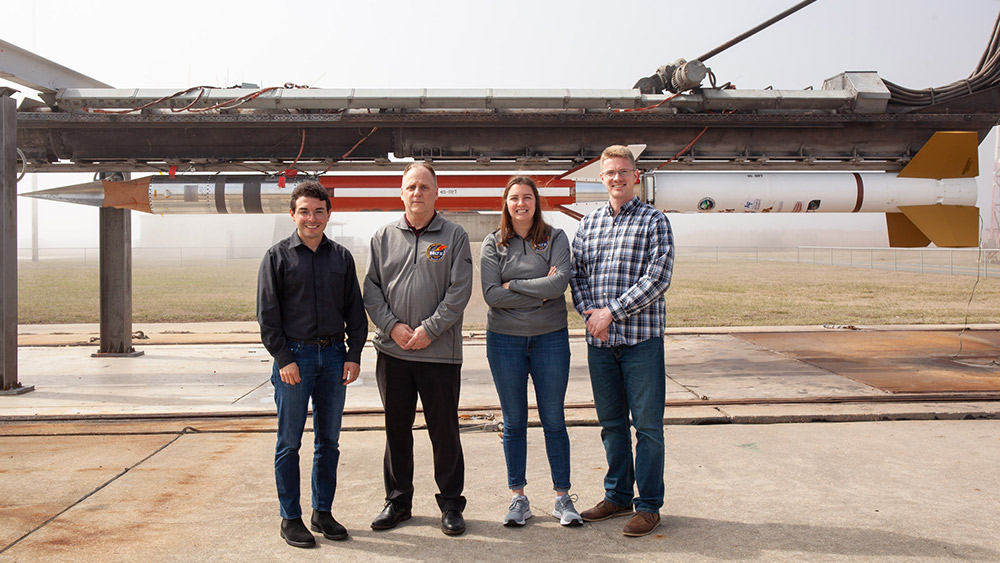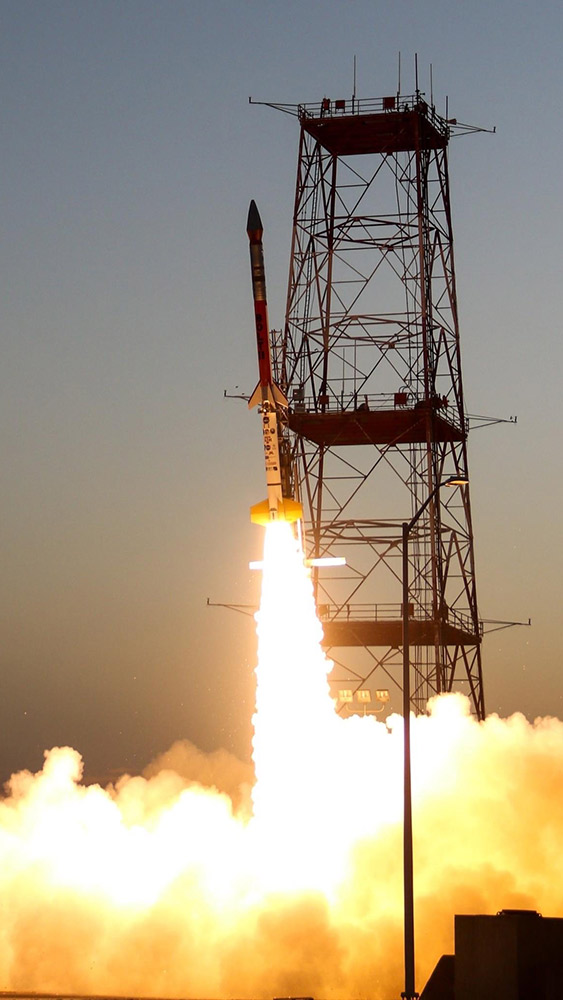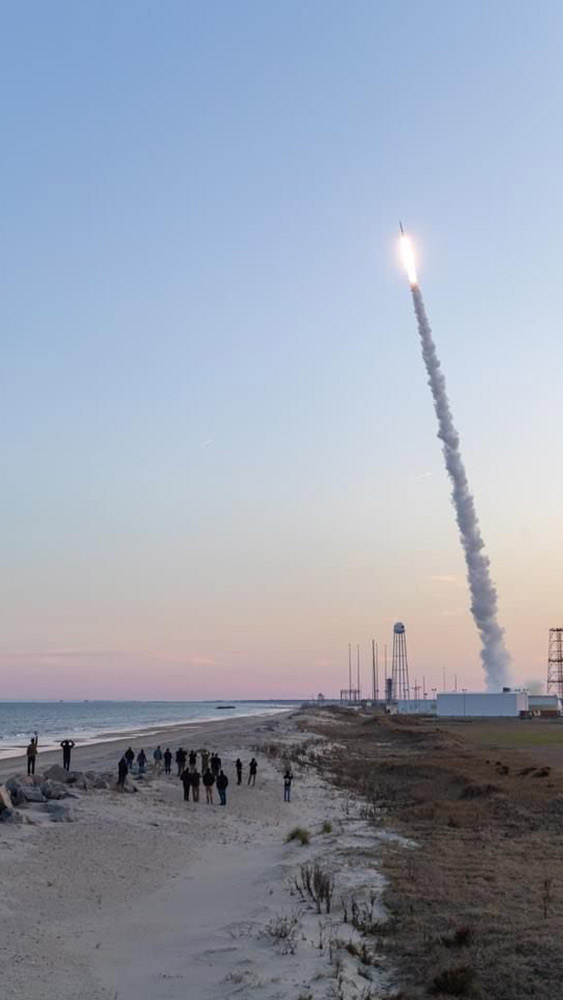
Texas A&M University is leading the second stage of a widely collaborative science mission to better understand elements of hypersonic flight. BOLT II, a suborbital sounding rocket, was designed to provide information about Boundary Layer Turbulence (BOLT II) during hypersonic flight.
The flight experiment, managed by the Air Force Research Laboratory (AFRL)/Air Force Office of Scientific Research (AFOSR), launched on March 21 from the NASA Wallops Flight Facility in Virginia. The successful 10-minute flight brings in new scientific data to further our understanding of drag and heating at hypersonic conditions.
Dr. Rodney Bowersox, professor in the Department of Aerospace Engineering at Texas A&M, served as the lead principal investigator (PI) for this effort. Drs. Helen Reed and Edward White, professors in the aerospace engineering department, were co-PIs on the projects. Aerospace engineering graduate students Heather Kostak, Bryan Morreale, John Wirth, Daniel Mullen and Eric Swinny all played integral roles in the three phases of the experiment.
“This project provided a great opportunity for the students and faculty to better understand the steps, teaming and attention to detail required for a successful flight experiment,” said Bowersox. “This team interacted on a weekly basis with the Air Force, Calspan-University of Buffalo Research Center (CUBRC), NASA and NASA Sounding Rocket Operations Contact. The result was a successful hypersonic flight experiment, and I am incredibly proud of the entire team.”

Mapping out dynamics
One of the most important questions that needed to be answered before launch day was will the rocket fly straight? According to Bryan Morreale, a doctoral student in the aerospace engineering department, that's a harder question to answer than one might think. Especially because of the unique geometry of BOLT II.
"My main contribution was looking at the external aerodynamics of the whole flight system," said Morreale. "Myself and another graduate student, Eric Swinny, generated aerodynamic databases to determine the flight performance of the rocket."
Morreale and Swinny worked closely with experts from NASA Wallops and the Johns Hopkins University Applied Physics Laboratory (JHUAPL) to determine the flight stability for BOLT II.
"One of the most important things about BOLT II is that it's an unclassified problem for the community to all work on together," said Morreale. "I came into this with limited knowledge, but I left knowing unbelievable amounts more from having access to the nation's best and brightest engineers working on these problems."
Morreale was also a key player in helping to determine where to place the more than 400 sensors and instruments on the vehicle.
"We have the rocket, and at the end of the rocket, we have the BOLT II payload, which has these swept leading edges," he said. "The edges cause the air to rush in and create a very complicated flow pattern, so what the instrument designers want is to get a rough idea of what the air will do at a specific moment in flight."
To help them determine the best way to capture information during the flight, he developed higher fidelity fluid dynamics simulations that could explain what the flow over the vehicle's surface would look like.
Laying the groundwork
The placement of those 400-plus sensors was critical to the success of the flight mission. To create a wealth of data from this experiment, the vehicle had two different instrument layouts. One side of the vehicle was designed to capture the natural breakdown to turbulence during flight. The other side served as a trip side that captured data from forced transition and turbulence during hypersonic flight.
Heather Kostak ’16, ’20, ’22, a former student from the aerospace engineering department, was in charge of instrumenting the natural side, which would be equipped with the majority of the sensors. She looked at ground test data and simulations to inform the instrumentation layout.
"We first tested in the wind tunnels at Texas A&M, and on just a rough 3D-printed model, we saw breakdown," said Kostak. "This breakdown informed us that we need to place instruments in that region to see what modal growth and instabilities are present."
She also relied on the data from Morreale's and Mullen’s simulations for laminar and turbulent flow, along with results from JHUAPL and her knowledge from previously working on BOLT.
After instrumenting the entire vehicle, Kostak and their team traveled to New York to test the full-scale vehicle at CUBRC.
"We tested the entire flight vehicle, with all of the instrumentation, which has not been done before, so that was a really unique opportunity to be a part of," said Kostak.
Because of their ability to replicate expected BOLT II flight conditions in CUBRC's facilities, researchers now have the opportunity to compare more precise data between the flight experiment and ground tests.
"That's the whole picture, all together," said Kostak. "How did the flight data compare to our simulations and ground test work? Are we predicting what actually caused transition to turbulence on the flight vehicle? That's what I'm curious about because that will impact the aerospace industry."

Drumming up the data
The successful launch of BOLT II brings in unprecedented data for the teams to begin processing and breaking down. Air Force 1st Lt. John Wirth, a doctoral student in the aerospace engineering department, is one of the first to look at this information.
"We have some excellent data, and I'm really excited to see how it all lines up," said Wirth. "You have this complicated 3D geometry with a lot going on, so step number one is just to look at the flight trajectory."
Wirth's role is to take the exponential amount of data from the flight test and reduce it to usable information. He is working with partners at AFRL, NASA and CUBRC to determine the angle of attack, Mach and altitude. His role is to put the flight data through the 3D heat flux analysis he developed as part of his doctoral research.
"If we can validate our theories and actually understand what's happening with the physics, then we can make better engineering decisions and enable the next generation of hypersonics," he said.
The data from BOLT II gives the hypersonics community real-world information that provides long-awaited answers and opens the door for new discoveries. For Wirth, the opportunity to work directly with the flight experiment data alongside a collaborative team has been a uniquely rewarding experience.
"It feels good being a part of a nationwide team doing something that's important for our whole country," said Wirth. "That definitely gives you a lot of satisfaction at the end of the day."
Texas A&M is the first university to lead a flight test. Key collaborators on the science mission included CUBRC, NASA, University of Minnesota, United States Air Force Academy, University of Maryland, University of Arizona and JHUAPL.
"It is amazing to watch the students rise to the occasion and take the lead on critical elements of the BOLT II flight experiment,” said Sarah Popkin, who oversees the project as AFOSR’s Program Officer for High-Speed Aerodynamics. “The computational fluid dynamic simulations sensor placement to chase the science and data post-processing have all proven to be so important to our success. These students and this project are a prime example of how AFOSR contributes to workforce development, capacity building and creating the next generation of scientists and engineers."
